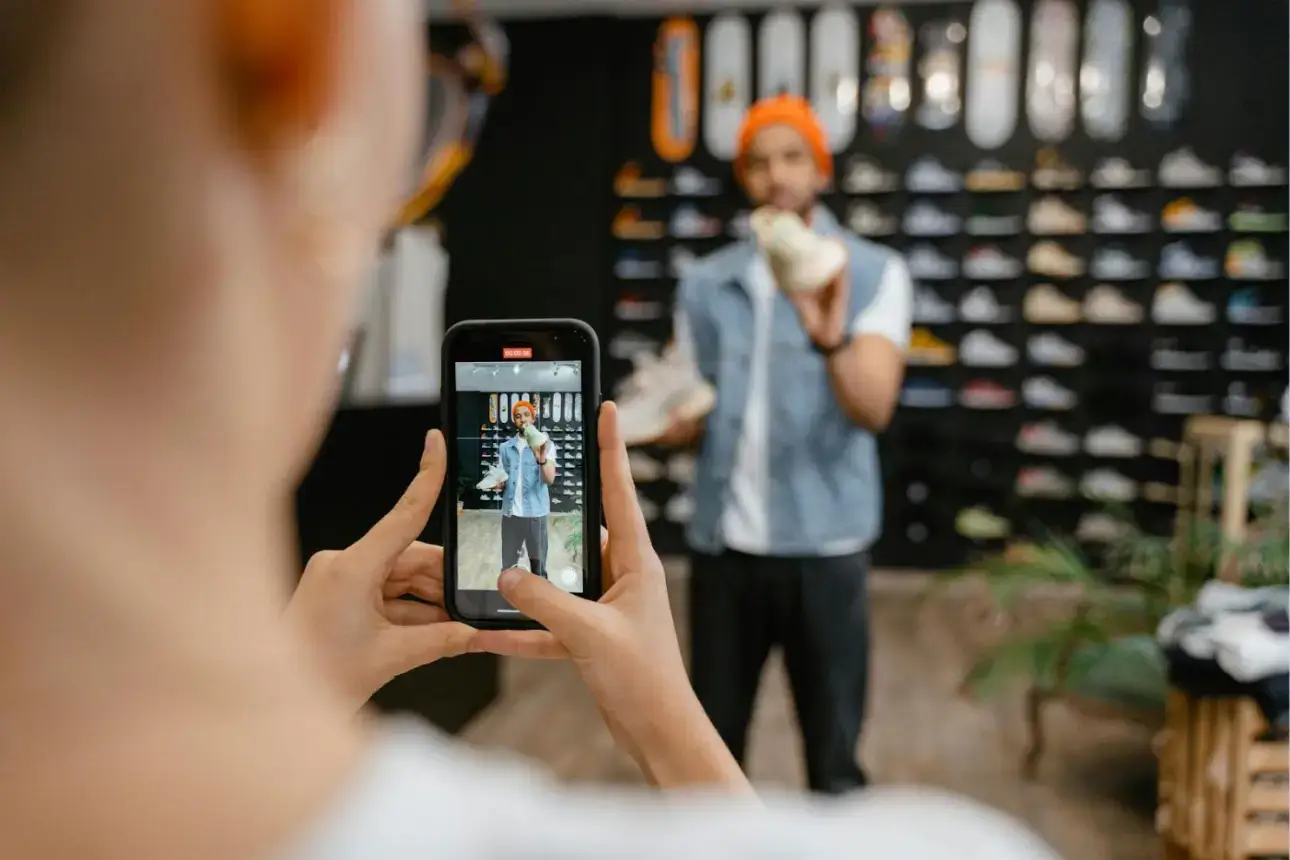Trust is important in every business, but it’s especially important in e-commerce.
Back in the day, brands would run expensive advertising campaigns to present themselves as trustworthy brands. But that’s not an option for smaller businesses, and it might not even be that effective anymore.
Consumers don’t trust advertising as much as they used to, and instead prefer ‘social proof’, i.e. they trust brands that other people trust. That’s why user-generated content (UGC) has become such an important aspect of building trust with e-commerce consumers.
The stats support it: 84% of consumers are more likely to trust a brand’s marketing campaign when it features UGC, and 74% trust UGC more than brand-provided content on product pages.
So, let’s take a look at how UGC can help build trust with your e-commerce customers and what you need to do to use it effectively.
In this article:
- The Value of User-Generated Content (UGC)
- Popular Types of User-Generated Content
- How to Encourage Customers to Share UGC
- Integrating UGC into Your E-commerce Strategy
- Top Tools for Managing and Monitoring UGC

Source: Pexels
The Value of User-Generated Content (UGC)
On its surface, UGC is free content, which equals more organic traffic and hopefully more leads. But that’s just looking at things superficially. In reality, the true value of UGC is embodied in its:
Authenticity and Trust
Consumers have become jaded by traditional advertising. UGC sidesteps skepticism by showcasing genuine customer experiences.

Source: Pexels
When shoppers see unscripted reviews, photos, or videos from peers, they value that content as being more authentic and reliable. Transparency builds trust: 79% of people say UGC is a major influence on their purchasing decisions.
Enhancing Brand Visibility and Connection
UGC campaigns can also be a great way to raise your brand’s profile. When customers share their experiences on social media or forums, they introduce your brand to their networks organically.
Additionally, UGC is a great step towards building a community of loyal customers. Customers will appreciate you highlighting their stories, and it positions your brand as one that values its audience.
Impact on Purchasing Decisions
Peer recommendations have always been important, but their impact can be seen clearly when it comes to e-commerce. A staggering 88% of shoppers trust online reviews as much as personal recommendations.
They perceive UGC as objective endorsements: customers view it as unbiased advice, not a sales pitch. Even a handful of genuine reviews can tip the scales in your favor.
Popular Types of User-Generated Content

Source: Pexels
Customer reviews really are the backbone of user-generated content.
You often see shoppers leaving detailed feedback on platforms like Google Reviews or Trustpilot, where they share praise, details, and even the occasional drawback. This kind of honest, nuanced review tends to feel much more genuine than a simple five-star rating.
They make products feel more relatable and help the brand connect with people in a fun, informal way.
Then, there are blog posts, which provide a deeper dive into a product’s story. When someone takes the time to write a detailed review or a how-to guide, it gives potential buyers a wealth of insights that short reviews just can’t match.
Online forums, like Reddit and Quora, offer a space for candid conversations where users share real-life experiences and seek advice.
These discussions can be a proper directory and a goldmine for both customers and brands, as they allow brands to address concerns directly while also reinforcing trust through genuine dialogue (plus, it’s valuable market research).
Lastly, visual content plays a huge role. When customers upload photos or videos on product pages, it helps everyone get a better sense of how the product looks in real life.
For instance, a clothing brand that features user photos alongside professional shots can really help shoppers feel confident about the fit and quality.
How to Encourage Customers to Share UGC

Source: Pexels
Want to get customers excited about sharing their experiences with your brand? Start by creating moments that feel worth posting.
Think about the little things—like fun packaging, a handwritten thank-you note, or a surprise freebie. These touches don’t just make someone’s day; they practically beg to be shared on Instagram or TikTok.
If you really want to kick things up a notch, try running contests or challenges.
Picture this: Ask folks to post their “Best DIY Project” using your tools, and reward the most creative entry with a discount or a feature on your website. People love friendly competition, and you’ll get a ton of authentic content in return.
Don’t underestimate the power of rewards, either. Offer loyalty points, early access to new products, or exclusive perks to customers who leave reviews or share posts. Just be upfront about how you’ll use their content—no one likes surprises when it comes to their photos or words.
Once the content starts rolling in, it’s time to find ways to use UGC in your campaigns.
Sprinkle customer photos on product pages, drop social posts into blog articles, or carve out a “Customer Stories” section on your site. It’s a win-win: Shoppers trust real people more than ads, and your fans feel like VIPs when their post gets spotlighted.
Oh, and don’t forget to show some love to the folks creating content. A quick “Thanks for sharing!” comment or a shoutout in your email newsletter goes a long way.
Spot a truly amazing post? Surprise the customer with a freebie or a feature in your product feed—it’ll turn them into a lifelong fan.
Lastly, make it easy for people to participate. Not everyone’s a pro at staging photos or writing reviews.
Share simple templates, lighting hacks, or examples of great posts to guide them. The clearer the instructions, the more people will jump in!
Integrating UGC into Your E-commerce Strategy
When it comes to making the most of user-generated content (UGC), start by weaving customer reviews and photos directly into your product pages.
There are tools that can help automate how you collect and use UGC, so shoppers see real-life feedback and visuals right below your product descriptions, with no endless scrolling required.
And why stop there? Consider creating dedicated galleries on your site to showcase customer photos in action.
For example, a home decor brand could organize images into themes like “Customer Living Rooms” to highlight how products look in diverse, authentic spaces. They can also add QR codes to photos taken by customers and link directly to the product pages.
To boost credibility even further, integrate third-party reviews from platforms like Yelp or Facebook using simple widgets. This adds an extra layer of “social proof” since customers often trust external sites more than curated testimonials. But don’t let that UGC gather dust—repurpose it!
Drop customer quotes into email campaigns, social ads, or even packaging inserts. A heartfelt testimonial in a promotional email can nudge hesitant buyers to click that “Shop Now” button.
Finally, turn inspiration into sales by making UGC shoppable. Incorporating visual search functions allows people who see a product they like in UGC to go straight to purchasing it. It’s a seamless way to bridge the gap between browsing and purchasing, all while letting your customers’ creativity do the heavy lifting.
Top Tools for Managing and Moderating UGC
When it comes to handling user-generated content, you’ve got options. The right UGC platform can be a lifesaver for businesses looking to collect and showcase UGC across websites, social media, and more.
They’re not just fancy aggregators; many come with built-in moderation tools and analytics dashboards, and even plug straight into e-commerce systems like Shopify.
Don’t be shy about curating the really good stuff—like customer photos or reviews that make your product shine—to feature on your homepage or product pages.
How to Measure the Impact of UGC on Sales
Okay, so you’ve got UGC flowing in—how do you know it’s working?
Start by tracking basics like likes, shares, and comments. But dig deeper, too: check if pages with UGC (like customer review sections) are actually driving sales.
Tools like Google Analytics or specialized UGC dashboards can help connect the dots between that glowing Instagram post and a spike in checkout clicks.
Don’t sleep on customer feedback, either. Read between the lines of reviews and comments. Are people obsessed with your product’s durability but side-eyeing your shipping times? Those little nuggets of truth are pure gold for tweaking your strategy.
Play the long game. Compare metrics every few months to spot trends. If UGC sales always pop off during the holidays, double down on festive campaigns next year.
FAQs about User-Generated Content in E-commerce
1. What is user-generated content in e-commerce?
User-generated content, or UGC, in e-commerce refers to any media that your customers create and share about their experiences with your products.
This includes everything from authentic reviews and testimonials to candid photos and videos posted on social media.
Unlike traditional advertising, UGC is inherently genuine and offers a relatable glimpse into real-life product use, which builds trust and social proof among potential buyers.
Research indicates that a significant majority of consumers trust the opinions of peers over brand-curated content, making UGC a powerful tool for establishing credibility.
2. What are examples of user-generated content for e-commerce brands?
Many brands showcase detailed customer reviews and testimonials on their product pages, providing honest insights into product quality and usability.
In addition, authentic photos and videos, like unboxing clips, styling tips, or day-in-the-life uses, are shared on social media platforms, helping to humanize your brand and create a community feel.
3. How do I collect user-generated content as an e-commerce brand?
Collecting UGC starts with creating an environment that encourages customers to share their experiences.
One effective strategy is to incorporate clear calls-to-action on packaging, receipts, and your website, inviting customers to post reviews or photos using a branded hashtag.
Running engaging contests or offering incentives like discounts can further motivate participation.
Conclusion
User-generated content is more than a marketing tactic; it’s a bridge between your brand and your customers. It’s a cost-effective way to build trust, enhance visibility, and drive sales.
Integrating authentic customer voices into every touchpoint creates a shopping experience that feels personal, reliable, and irresistibly engaging.
Start small: Encourage reviews, celebrate customer creativity, and watch trust and revenue grow.

Author Bio
Magnus Eriksen is a copywriter and e-commerce SEO specialist with a degree in Marketing and Brand Management. Before embarking on his copywriting career, he was a content writer for digital marketing agencies such as Synlighet AS and Omega Media, where he mastered on-page and technical SEO.

